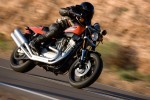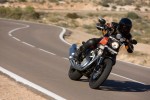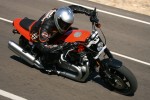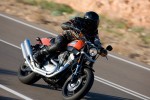By Steve Smith
 In a very simplistic view of the types of motorcycle crashes, it can be said they fall into two types: Motorcycle only and those with other vehicles. It’s important to note that there is rarely a single cause of motorcycle crashes. Most times a combination of factors interact and lead to a crash.
In a very simplistic view of the types of motorcycle crashes, it can be said they fall into two types: Motorcycle only and those with other vehicles. It’s important to note that there is rarely a single cause of motorcycle crashes. Most times a combination of factors interact and lead to a crash.
In this column, I will focus solely on one aspect of motorcycle-only crashes – those that happen in turns. Statistics have demonstrated that 30 percent or more of single vehicle motorcycle crashes happen in curves. In a well known study, it was concluded that most often these crashes were caused by rider error during cornering.
Let’s take a quick look at 5 common cornering mistakes.
Wrong Approach Position
Not approaching from the outside portion of the travel lane of a turn limits the distance  the rider can see into the turn. Seeing further into the turn allows riders to see the turn conditions such as slope and sharpness of the turn as well as possible hazards that may be in the turn. Where you look is where you go – if you look at the exit of the turn you will go toward that direction. I’ll touch on visual directional control later.
the rider can see into the turn. Seeing further into the turn allows riders to see the turn conditions such as slope and sharpness of the turn as well as possible hazards that may be in the turn. Where you look is where you go – if you look at the exit of the turn you will go toward that direction. I’ll touch on visual directional control later.
Too Fast Entry Speed
Entering into a turn too fast can be dangerous, because once into the turn speed correction can cause loss of traction. Consider that traction is shared between cornering, braking, and  driving forces. When in a turn, a significant portion of a tire’s traction is used. The amount of remaining available traction can easily be exceeded by applying the brakes or decelerating (engine braking is similar to applying brakes) while in a turn. Loss of traction results in tire skid and a possible crash. Complete all slowing prior to the turn. MSF defines a proper entry speed as one that will allow a slight increase of speed throughout a turn.
driving forces. When in a turn, a significant portion of a tire’s traction is used. The amount of remaining available traction can easily be exceeded by applying the brakes or decelerating (engine braking is similar to applying brakes) while in a turn. Loss of traction results in tire skid and a possible crash. Complete all slowing prior to the turn. MSF defines a proper entry speed as one that will allow a slight increase of speed throughout a turn.
Lack of Head Turn
Not turning the head to look all the way through a turn is a very common mistake I have  seen new and experienced riders make. I can’t say this enough… Where we look is where we go. Think of a time when you were focusing intently on a pothole in the road. What happened as you approached it? Most likely you hit it instead of avoiding it. Have you ever drifted slightly toward the side of the road when you turned you head to look at something out a side window? That’s visual directional control at work.
seen new and experienced riders make. I can’t say this enough… Where we look is where we go. Think of a time when you were focusing intently on a pothole in the road. What happened as you approached it? Most likely you hit it instead of avoiding it. Have you ever drifted slightly toward the side of the road when you turned you head to look at something out a side window? That’s visual directional control at work.
Improper Path of Travel
Using an incorrect path of travel can make it more difficult to navigate a turn. A desirable  path consists of entering and exiting near the outside of your lane, while being near the inside of your lane at the apex of the turn. This will get us the best approach position to give good visibility into the turn and lessens the degree of sharpness of the turn. The result is a turn that requires less lean angle and less chance of hard parts of the bike touching the ground and causing a loss of traction.
path consists of entering and exiting near the outside of your lane, while being near the inside of your lane at the apex of the turn. This will get us the best approach position to give good visibility into the turn and lessens the degree of sharpness of the turn. The result is a turn that requires less lean angle and less chance of hard parts of the bike touching the ground and causing a loss of traction.
Poor Throttle Usage
Do not be choppy on the throttle or decelerate in a turn. A steady or slight increase of  throttle throughout the turn is important to keep the suspension stabilized.
throttle throughout the turn is important to keep the suspension stabilized.
Also, I’ve already mentioned the issue of braking or slowing in a turn. Remember, it is better to accelerate out of a turn than to slow while in it. As the racers say, “Slow in, fast out.”
(Photos courtesy of Harley-Davidson)
 Ride CT & Ride New England Serving New England, NYC and The Hudson Valley!
Ride CT & Ride New England Serving New England, NYC and The Hudson Valley!


